
How to Use Video Production to Boost Your Brand Awareness
In the UK, nearly 82% of online traffic comes from videos. This shows a big change in how people get their information. Brands that don’t use video risk being left behind.
Video marketing is key in today’s digital world. 54% of internet users look for videos on websites. Businesses that don’t make videos miss out on chances.
Video content grabs attention and changes it. Emails with “video” in the subject line get 19% more opens and 65% more clicks. This shows its power to stand out online.
In B2B, 70% of buyers want video content when making decisions. Video production helps in two ways: it connects emotionally through stories and boosts SEO and sales.
Key Takeaways
- Video content drives 82% of UK online traffic, making it essential for modern marketing strategies.
- Emails featuring video content see 65% higher click-through rates, boosting engagement.
- Professional video production strengthens brand messaging by combining storytelling with visual impact.
- Brands using video marketing improve SEO through increased dwell time and shareability.
- Video content effectively communicates brand values, products, and services across social media and websites.
Video production is a game-changer for any business, big or small. This guide shows how to use video marketing to increase recognition, drive sales, and connect with people. We’ll cover production tips and how to share videos to lead your market in the UK.
The Power of Video Production in Modern Brand Building
Video content creation is key for building brands in the UK. With over 82% of online traffic now video-based, using professional video production helps businesses stand out. Here’s how video changes how people see your brand:
Why Video Outperforms Other Formats
Humans see visuals 60,000 times faster than text. Video marketing uses both sight and sound, making it more engaging. This leads to better memory retention, 55% more than audio alone. This makes video perfect for getting noticed in a crowded digital space:
- Video grabs attention quickly, lowering bounce rates
- 70% of B2B buyers prefer interactive video content
- Brands using promotional video production see a 64-85% increase in conversion intent
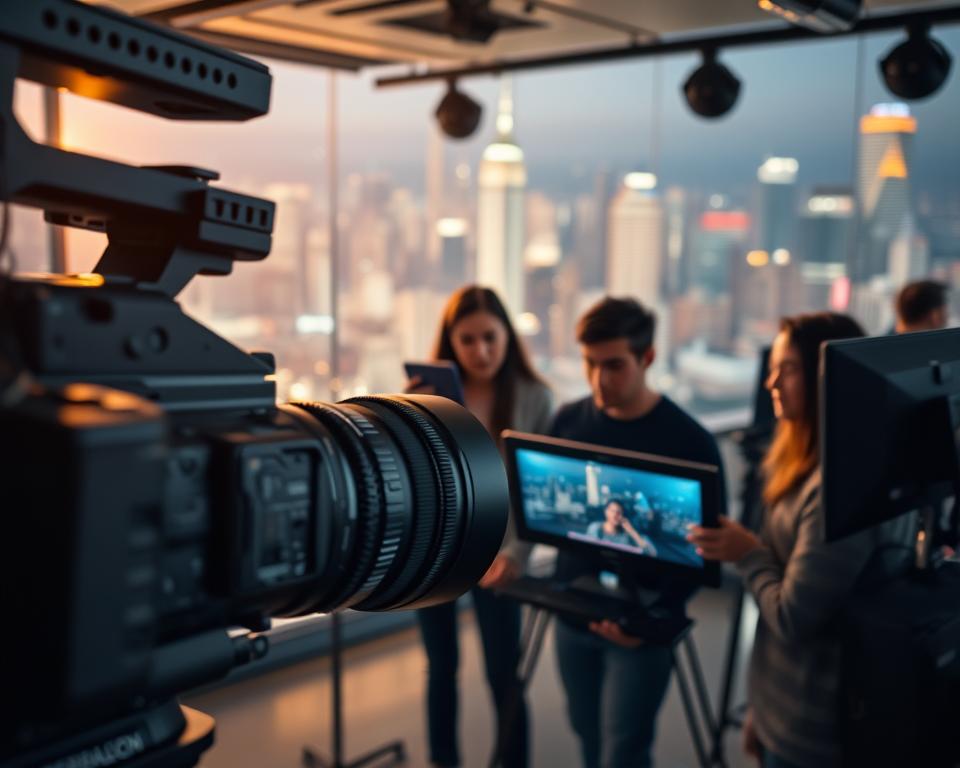
Key UK Video Consumption Stats
British viewers watch 17 hours of online videos weekly. This opens up big opportunities for businesses:
| Metric | Statistic |
|---|---|
| Video marketing ROI | 54% of UK users prefer video over text for product research |
| Engagement | 94% of consumers use videos to learn about products |
| SEO benefits | Videos increase page engagement time by 2-3x |
Building Emotional Connections
Good video production connects with viewers on an emotional level. Small Films’ work for Mallow & Marsh shows this: their 30-second ads got 22% higher recall rates. They used uplifting music and real employee stories. Emotional storytelling in video content creation:
- Builds trust through stories that feel real
- Creates a strong brand identity with consistent visuals
- Increases social sharing (videos are 1200% more shareable than text)
“Videos shorten the path from awareness to action by 40%.” – 2023 UK Digital Marketing Report
For brands wanting to be noticed, focusing on video production is key. The data shows video isn’t just a trend—it’s the new way to connect with audiences.
Understanding the Video Production Process
Effective video production is a structured process. It turns ideas into engaging content. Professionals create videos that meet brand goals through this process.
- Pre-production: Start with a clear brief outlining objectives, audience, and style. Scriptwriting, storyboarding, and logistics planning happen here.
- Production: This phase involves filming on set, managing talent, and capturing high-quality visuals and audio. Adjust lighting and aspect ratios for different platforms.
- Post-production: Use video editing services to refine footage. Add colour grading, sound effects, and text. Tools like Riverside streamline remote editing and collaboration.

| Phase | Key Steps |
|---|---|
| Pre-production | Script development, budgeting, location scouting |
| Production | Shooting, directing, technical setup |
| Post-production | Editing, visual effects, final quality checks |
Each stage needs attention to detail. Post-production includes colour correction and sound design for consistency. Repurposing content across platforms maximises reach.
Whether it’s a 30-second ad or a documentary, clear objectives guide every decision. Professional video editing services ensure polished results. Tools like Riverside make remote collaboration easy.
Even small businesses can achieve professional outcomes. Focus on quality audio, stick to timelines, and align with audience insights.
Essential Types of Videos for Increasing Brand Recognition
Choosing the right video formats is key to making an impact with your corporate video production. Each type has its own role, from building trust to showing off your expertise. For example, 96% of viewers use explainers to get a product, and 89% are more likely to buy.
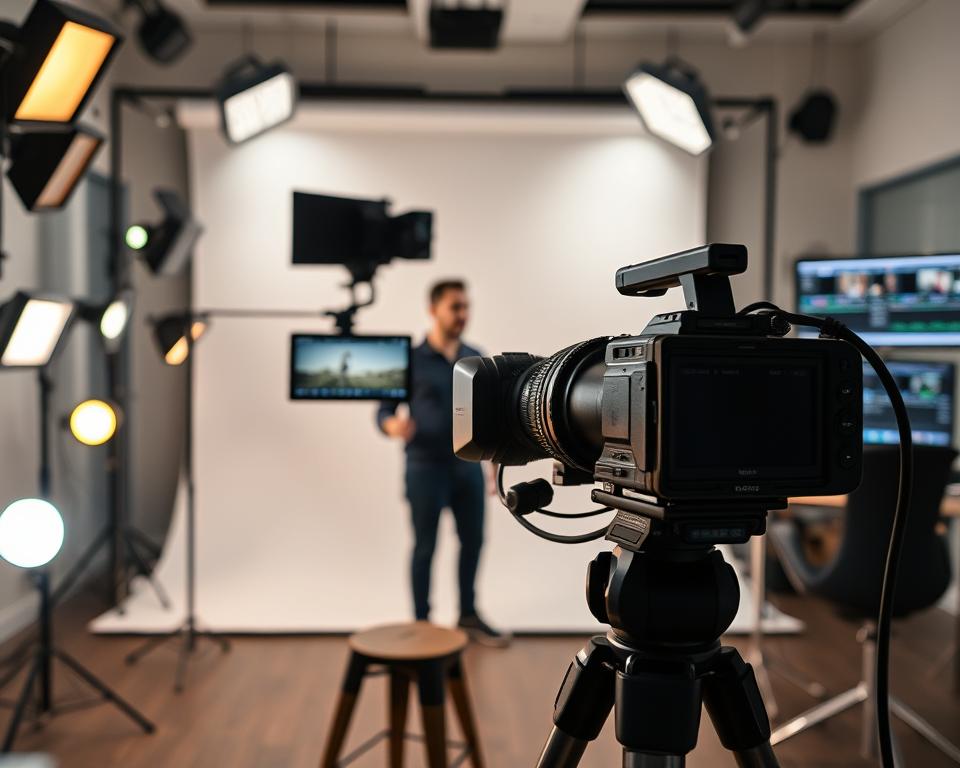
90% of consumers trust peer recommendations, making customer testimon videos a powerful tool for boosting brand recognition.
| Type | Purpose | Example |
|---|---|---|
| Brand Story | Showcase values | Roots Cut Flower Farm |
| Product Demo | Feature demonstration | Ink or Dye tutorials |
| Testimonials | Social proof | Customer reviews |
| Thought Leadership | Industry authority | Sustainability webinars |
A professional video production team can capture behind-the-scenes moments. This makes your brand feel more human and less corporate. For instance, a video production company might film staff interviews to show your mission-driven work.
Focus on real stories instead of scripted ones to avoid coming off as too salesy.
Use video content creation for short, clear demos that explain features without jargon. Start by naming a problem, like ‘How to reduce waste with eco-friendly packaging’, then show how you solve it. Use close-ups and clear voiceovers to keep it professional.
These videos help increase awareness during the buyer’s consideration stage.
Show customers who’ve solved common problems with your product. Case studies should follow a problem-solution-outcome structure. For example, a manufacturing firm might show how your software cut downtime by 30%.
Always get GDPR-compliant permissions before using customer data. Testimonials on social platforms can boost engagement by 85% compared to generic ads.
Host live panels or industry analyses to show your brand’s authority. A video production company can film expert interviews at events like the London Tech Summit. High production quality is important—78% of B2B buyers judge brands by video professionalism.
Live streams of webinars create a sense of urgency, encouraging viewers to act fast.
Professional Video Production vs. In-House Creation: Making the Right Choice
Deciding between a video production company and an in-house team depends on your brand’s goals and resources. A mix of both can often be the best choice. But knowing when to choose one over the other is essential.
“72% of companies use a combination of outsourced and in-house talent for video production.”
When to Hire a Video Production Company
For big, important projects, a professional video production agency is the way to go. They’re great for making a brand anthem or complex videos like 360-degree ones. Red Bull, for example, uses agencies for big campaigns to keep their global presence strong.
Smaller companies without the right equipment, like 4K cameras or green screens, should outsource. This helps avoid mistakes in their videos.

Building an Internal Video Team
Brands that need videos all the time, like Progressive Insurance, often have their own teams. Starting a video team costs around £20k for basic equipment. These teams are good at making quick videos for social media, keeping the brand’s message consistent.
But, growing a team means hiring people with skills in video production and editing.
Hybrid Approaches for Different Content Needs
Many companies mix both methods. Marriott, for example, makes quick ads in-house but outsources big campaigns. Vidyard also outsources filming but uses its team for video content creation.
This way, they keep creative control but get help for complex projects. It’s important to have clear agreements about what’s expected, like who owns the footage and when it’s ready.
Every business’s choice depends on their budget, how often they need videos, and what they need technically. Whether you choose a video production company or build a team, make sure it fits your brand’s goals. This way, your videos will engage your audience effectively.
Crafting a Video Content Strategy That Aligns with Your Brand
Every good video marketing plan starts with a strategy that shows off your brand. First, check your current messaging to make sure new video content creation fits your core values. It’s important to set SMART goals—specific, measurable, achievable, relevant, and time-bound.
For example, a UK retailer might want to increase brand recognition. They could aim to make 12 product demo videos in six months.
- Align video themes with brand voice: Does your content feel energetic, professional, or approachable?
- Map content to business milestones like product launches or holiday campaigns.
- Use buyer personas to tailor videos for different audience segments.
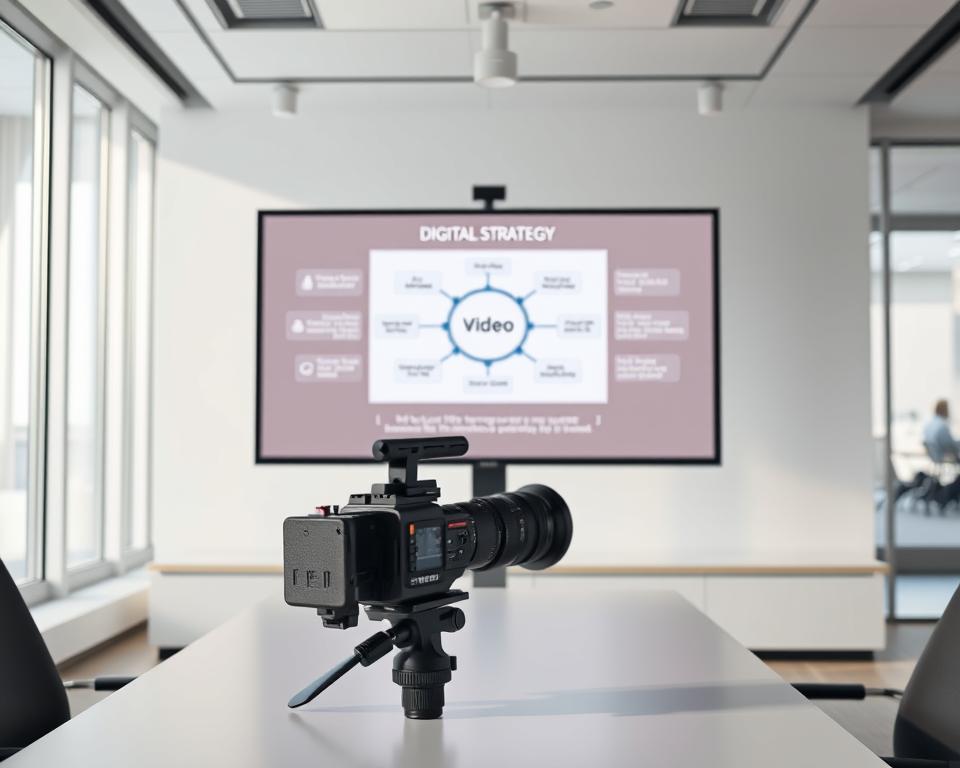
Make sure video titles and descriptions include SEO keywords. Tools like CapCut and Canva make editing easier. This helps keep your videos looking good on all platforms.
A 2023 study by Ofcom found 75% of UK consumers like brands that share real stories. So, focus on making videos that touch people’s hearts.
“A strategy without measurement is just wishful thinking.”
Use YouTube Analytics to see how well your videos are doing. Look at view duration and engagement. Use UTM parameters to find out which videos get people to visit your site.
Keep your content fresh by updating your calendar regularly. Mix evergreen content with timely trends. This way, your videos will help grow your brand’s value.
Budget Considerations for Corporate Video Production
Managing costs is key to making the most of video marketing without spending too much. Professional video production budgets can vary a lot. But with careful planning, every pound can help your brand grow. Here’s a look at costs and smart ways to spend for UK businesses.
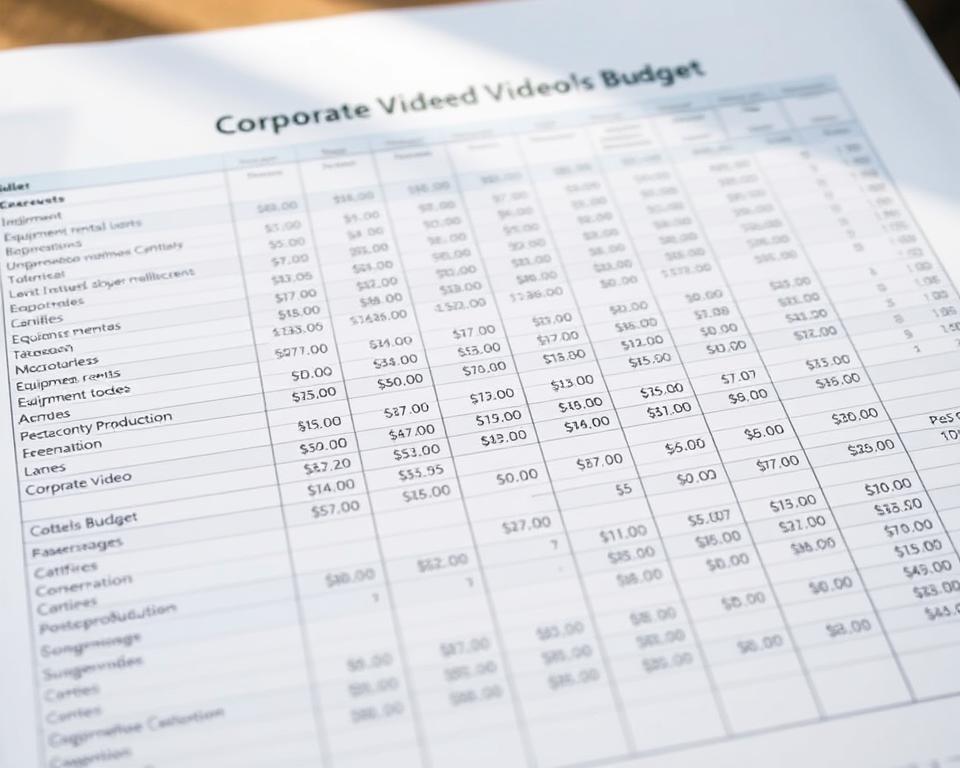
- Pre-production: Scriptwriting, storyboarding, and location scouting make up 20-30% of costs.
- Production: Equipment, crew, and logistics take 50% of budgets. Using in-house teams can save money.
- Post-production: Editing, animations, and sound design use 15-25% of budgets. Animation is often cheaper than live-action.
- Contingency funds (10-15%) help cover unexpected costs like permits or location changes.
Adding video marketing to campaigns can increase reach. Emails with ‘video’ in the subject line see a 19% increase in opens. A video production agency can help reuse content. Cut long videos into social clips or make landing page teasers.
Brands using repurposed video content see 30% higher engagement on LinkedIn and Instagram.
Begin with basic videos like customer testimonials, costing £1,500-£3,000. As budgets grow, invest in bigger projects like brand anthem films. Working with a video production expert ensures quality without breaking the bank.
Allocate 50% of budgets to production, then 30% to post-production. Don’t skimp on distribution—paid ads on YouTube or LinkedIn can double views. Animated promotional videos start at £400/minute, perfect for startups.
Technical Elements That Elevate Your Promotional Video Production

Technical skill in promotional video production makes good content unforgettable. Aspects like lighting, audio, and editing are key. They make sure every part of the video fits your brand.
Professional video editing services can adjust colours to match your brand. Good audio keeps viewers interested.
- Cinematography: Use dynamic angles and movement to highlight product details.
- Lighting: Soft key lights reduce shadows, ensuring clarity in product demos or corporate videos.
- Audio: High-quality microphones and background scores aligned to brand tone prevent distractions.
| Platform | Resolution | Aspect Ratio | Bitrate |
|---|---|---|---|
| YouTube | 1080p/4K | 16:9 | 5-8 Mbps |
| 1080p | 9:16 (vertical) | 3-5 Mbps | |
| TikTok | 1080p | 9:16 | 4 Mbps |
Make sure your video is easy to watch. Add captions for 25% of UK viewers who like them, says Ofcom 2023. Use descriptive audio for those who can’t see.
Test your video on different devices. Professional video editing services can tweak settings for the best viewing. With these technical skills, your video can build trust and stick in viewers’ minds.
How to Work Effectively with a Video Production Agency
Working with a video production agency needs careful planning. This ensures your brand goals and the agency’s work match. Here’s how UK businesses can succeed:
Finding the Right Partner for Your Brand
- Look for video production companies that focus on corporate videos. Check their storytelling skills, not just their technical abilities.
- Ask for examples from similar fields. For instance, a professional video production firm with healthcare experience might understand your needs better.
- Interview them to see if they fit your brand. Is their creative style and work pace right for you?
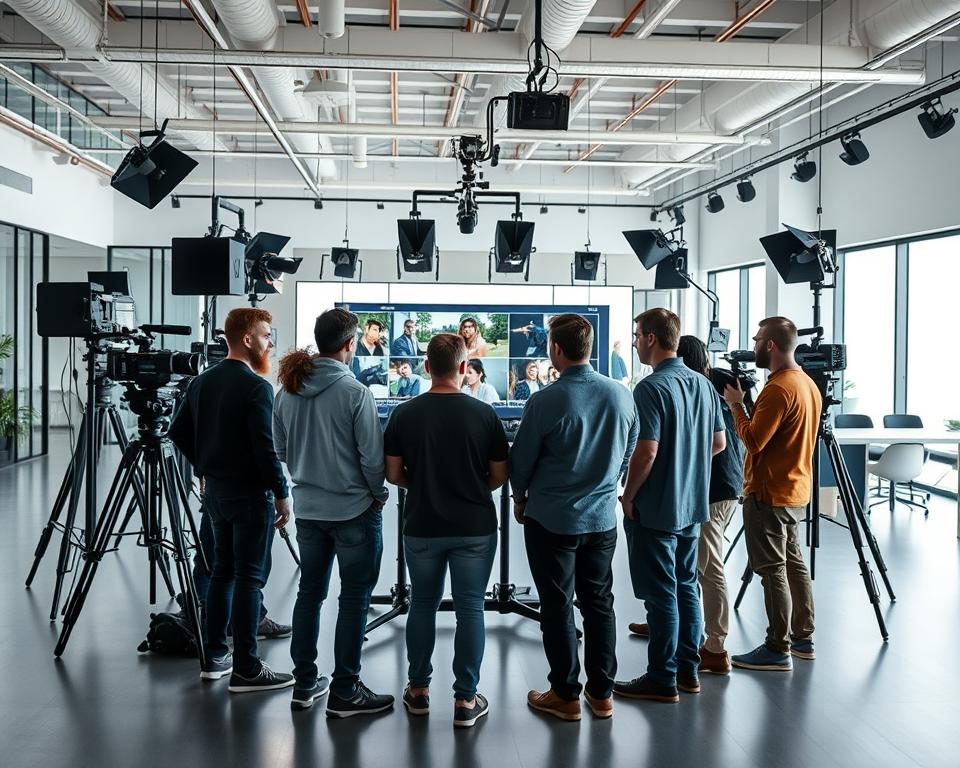
Establishing Clear Communication Channels
Begin with a detailed brief. Include your brand’s guidelines, tone, and goals. A UK marketing director suggests:
“Our best results came from sharing our brand style guide upfront and scheduling weekly check-ins.”
- Use tools like Trello to keep track of progress.
- Give specific feedback on drafts, like “The opening scene lacks urgency—can we add faster cuts?”
- Confirm the creative direction with a treatment package before filming starts.
Setting Realistic Timelines and Expectations
The video production process usually takes 6–12 weeks. It has several stages:
- Pre-production: Script approval, location scouting, casting
- Production: Filming, directing
- Post-production: Editing, sound design, colour grading
Make sure to have time for revisions. Avoid making last-minute changes without adjusting the deadline. Contracts should clearly state what you’ll get, like raw footage or usage rights.
Trust the agency’s skills but keep an eye on things. A good partnership means your campaign will reflect your brand’s voice and meet your audience’s needs.
Distribution Strategies to Maximise Your Video Content Reach
Effective distribution turns great video production into a powerhouse for brand awareness. Tailor your content to each platform’s strengths to maximise visibility. Start by optimising video specs for Instagram Reels (vertical 9:16), 15-60 seconds) or YouTube’s longer-form SEO.
Repurpose core assets into platform-specific formats without losing brand identity.

“Tailoring video lengths for TikTok and LinkedIn doubled our engagement,” says a spokesperson from UK fashion brand ASos. “Repurposing the same content for different platforms drove 30% more website traffic.”
Optimise for Each Platform’s Rules
- Instagram: Prioritise vertical videos with bold text overlays
- YouTube: Use keywords in titles and descriptions for SEO
- LinkedIn: Focus on 1-3 minute professional explainers
Paid vs Organic Reach
Paid video marketing boosts instant visibility via targeted ads on Facebook or Google. Organic growth thrives on community engagement—like Oatly’s TikTok challenges that organically reached 2M UK viewers through user-generated content.
Build a Content Ecosystem
- Create a series: Launch a YouTube vlog, then split it into TikTok clips
- Use calls-to action driving users from social media to your website
- Share behind-the-scenes content to build trust
Track metrics like watch time and CTR with tools like Google Analytics. Adjust strategies quarterly based on what resonates with UK audiences. Partnering with a video production agency ensures technical specs match platform requirements for optimal playback quality.
Measuring the Impact of Your Video Marketing Efforts
To measure video marketing success, you need to track important metrics. Start by setting clear goals, like boosting brand visibility or sales. Video marketing campaigns should match these goals for effective analysis.
Key metrics include
- Views: Total and unique viewers
- Engagement: Likes, shares, and watch time
- Conversions: Sales, sign-ups, or website visits triggered by videos
- ROI: Revenue generated compared to video production costs
A 2024 study found 91% of UK businesses use video production, with 90% seeing positive ROI. One brand saw a 400% ROI from a £5,000 video that brought in £20,000 in sales. Use tools like Google Analytics and Brandwatch to monitor these metrics.
| Metric | Definition | Tools |
|---|---|---|
| Reach | Number of users exposed to your video | YouTube Analytics |
| Engagement Rate | Percentage of viewers interacting with content | Social media insights |
| Conversion Tracking | Actions taken after viewing (e.g., purchases) | Google Ads |
| Brand Sentiment | Positive/negative audience feedback | Brandwatch |
Watch retention rates to see where viewers lose interest. A 60-second video with high retention means it’s engaging. Always check analytics to improve your campaigns. Use data to boost brand visibility and ROI.
Conclusion: Transforming Your Brand Awareness Through Strategic Video Content Creation
Video content is key in today’s brand strategy. With 87% of marketers using it, those who don’t risk being left behind. People want real stories, and over half of UK consumers want more from businesses.
Video helps build trust and keeps people engaged. It’s a powerful way to share your brand’s story or show off your products. This makes your brand stand out in a busy market.
Working with professional video production companies can help. They make sure your vision is brought to life and works well. Brands like Innocent Drinks and Burberry have found their identity through video.
Experts ensure your video looks great and reaches the right people. New trends like interactive videos and AI analytics will change how we connect with viewers.
Every brand starts with one video. Begin with a short story about your mission or a customer testimonial. Use YouTube and Instagram to see what works. With video expected to make up 82% of internet use, it’s a must for growth.
Start today to turn viewers into loyal fans. This will help your brand grow and become more known.